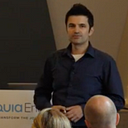Journey into the Cloud: The Transformation Perspective
Beyond Mere Adoption — The Continuous Journey of Innovation and Growth
The combined narrative of transformation and Cloud is a story of continuous growth, innovation, and self-discovery. It’s a story of acknowledging complexity, embracing change, and striving for a better, more efficient future. It’s a story that challenges us to rethink our approach to transformation and Cloud adoption, urging us to shift from a mindset of big-bang transformations and mere data migration to one of continuous evolution and strategic innovation.
In the grand narrative of digital evolution, we chronicle the tale of transformation, a journey that is not a destination but a continuous cycle of growth and self-discovery, much like our everyday lives. Imagine, if you will, a scenario where an individual decides to train for the Paris 2024 Olympics, despite life’s hurdles and the considerable investment in fitness gear. It’s a lofty goal, one that invites ridicule even. Yet, this is strikingly similar to how many organisations approach their technological and operational transformations.
Often, the term “transformation” is appended to buzzwords like “cloud,” “digital,” “data,” and “generative AI,” creating grand visions and allocating vast resources, but with vague, aspirational goals that often fail to meet the intended outcomes. This approach, reminiscent of the outdated management principles of the nineteenth and twentieth centuries, overlooks the fundamental understanding that transformations should be continuous and aligned with the organisational realities.
In this narrative, organisations are akin to complex, ambiguous systems that are not merely logical constructs, but intricate, interconnected entities. As Russell Ackoff, the organisational theorist, describes them, they are “messes” to be managed, not problems to be solved. We can consider four elements when attempting to improve such systems: the desired outcome, individual system components such as teams, the interactions between these components, and the feedback mechanisms that reinforce, amplify or dilute impact. These elements are often permeated with hidden assumptions, invisible dependencies, and unforeseen consequences.
Now, let’s shift our perspective to the all-pervasive phenomenon of cloud technology. Cloud, much like transformation, is a term that has become so ubiquitous that it risks losing its essence, often representing products unrelated to its true nature. We recognise the various flavors of Cloud — IaaS, PaaS, SaaS, and PaaS (Process) — yet, the real value lies in treating Cloud as a strategic business topic, a once-in-a-decade opportunity to fortify and prepare for the next crisis.
In this narrative, Cloud becomes the ‘Personal Trainer’ of your enterprise, encouraging the constant adoption of capabilities through quarterly releases. It challenges the legacy processes, the ‘body fat’ accumulated during the boom years of the 2010s, and urges you towards a leaner, more efficient future.
The key to understanding ‘true’ Cloud lies in recognising its features — On-Demand Usage, Ubiquitous Access, Multi-tenancy (Resourcing Pooling), Constant innovation, Elasticity (and Scalability), Measured Usage, Resiliency. Thus, a mere ‘Lift and Shift’ approach, migrating ECC to HEC, does not reap the benefits of the Cloud. It merely shifts the location of running your outdated processes.
The beauty of this narrative lies in the intersection of transformation and Cloud. On one hand, we have the continuous journey of transformation, acknowledging the complexity and the need for clarity and communication. On the other hand, we have the Cloud, pushing for constant innovation and challenging legacy processes. Both these narratives underline the need for an integrated approach, a cultural shift towards embracing change, and the proactive adoption of newer, better ways of working.
To make these changes sustainable, organisations must play the ‘Leadership Long Game’, where leaders are judged by the legacy they leave behind. They must become torchbearers of change, breaking down siloed behaviour and steering the organisation towards a shared future. This shift in mindset will help organisations embrace the complexity of change, making them better prepared for the future.
In the end, this narrative is not just about technological and operational transformations or the adoption of Cloud technology. It’s about making a conscious choice to evolve continuously, to strive for better, and to embrace the journey of self-discovery. It’s about viewing transformation projects not as bold leadership initiatives, but as reactions to past failures and opportunities for growth. It’s about treating Cloud not just as a technology, but as a strategic tool that drives innovation and challenges the status quo.
In the grand scheme of things, organisations should approach transformations as an ongoing process, a lifestyle choice, and not a one-and-done initiative. Big-bang transformations rarely succeed due to their inability to predict all consequences. Instead, organisations should favour a series of smaller, focused experiments and prototypes, akin to technology hackathons. These allow for testing of hypotheses, garnering support for ideas, and unveiling hidden assumptions and unexpected feedback loops.
This approach aligns well with the Cloud narrative. True Cloud adoption involves a continuous cycle of adoption and innovation, much like the transformation journey. It’s about more than just migrating your data and processes to the cloud; it’s about harnessing the power of the cloud to drive change, challenge outdated processes, and prepare for the future.
Communication plays a pivotal role in both these narratives. A shared vision, communicated effectively, can bring together disparate teams and individuals, uniting them towards a common goal. Storytelling, recognition, and other tactics can help overcome resistance to change, fostering a sense of belonging and shared purpose.
So, as we weave these two narratives together, we see that transformation and Cloud are not disparate concepts but intertwined aspects of the same journey. They both underscore the need for continuous evolution, the importance of clear communication, and the value of strategic, forward-thinking leadership.
